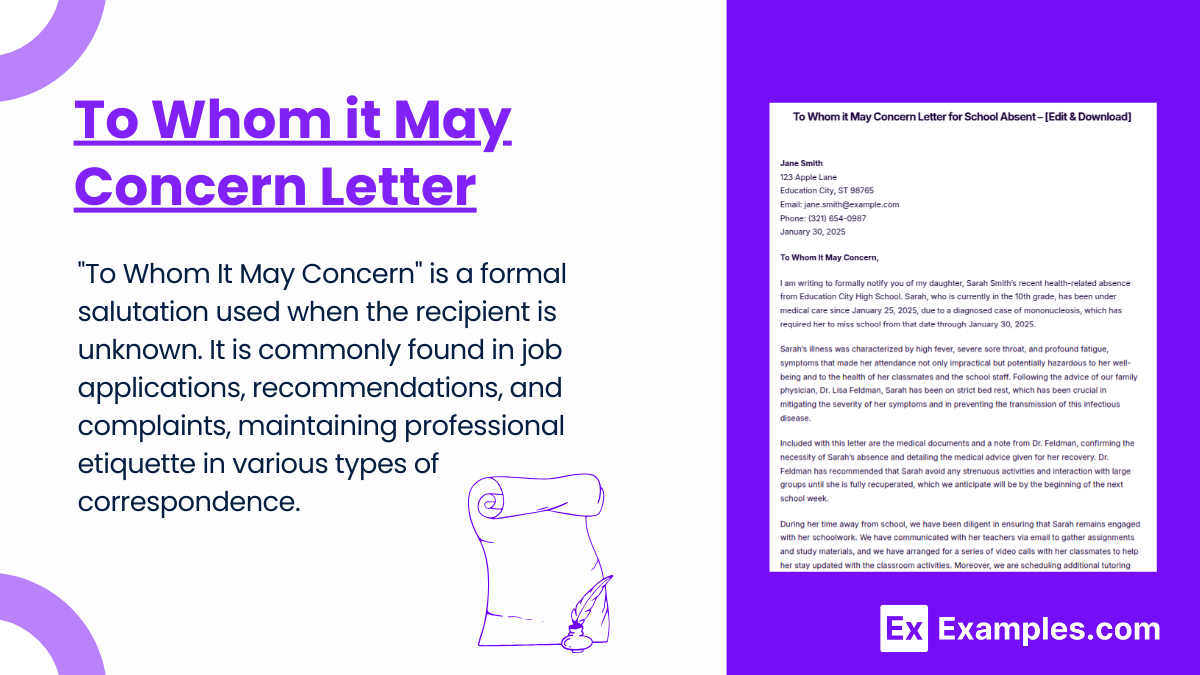14+ To Whom it May Concern Letter Examples
When addressing a letter where you don’t know the specific recipient, the phrase ‘To Whom It May Concern’ is a time-honored way to start. This formal introduction is not only a hallmark of professional etiquette but also a versatile opening for various types of correspondence, from job applications to recommendations or even complaints. In this guide, we’ll explore when and how to use ‘To Whom It May Concern,’ provide tips for crafting an effective letter with this salutation, and discuss modern alternatives that might be more suitable in certain contexts.
What is To Whom it May Concern Letter?
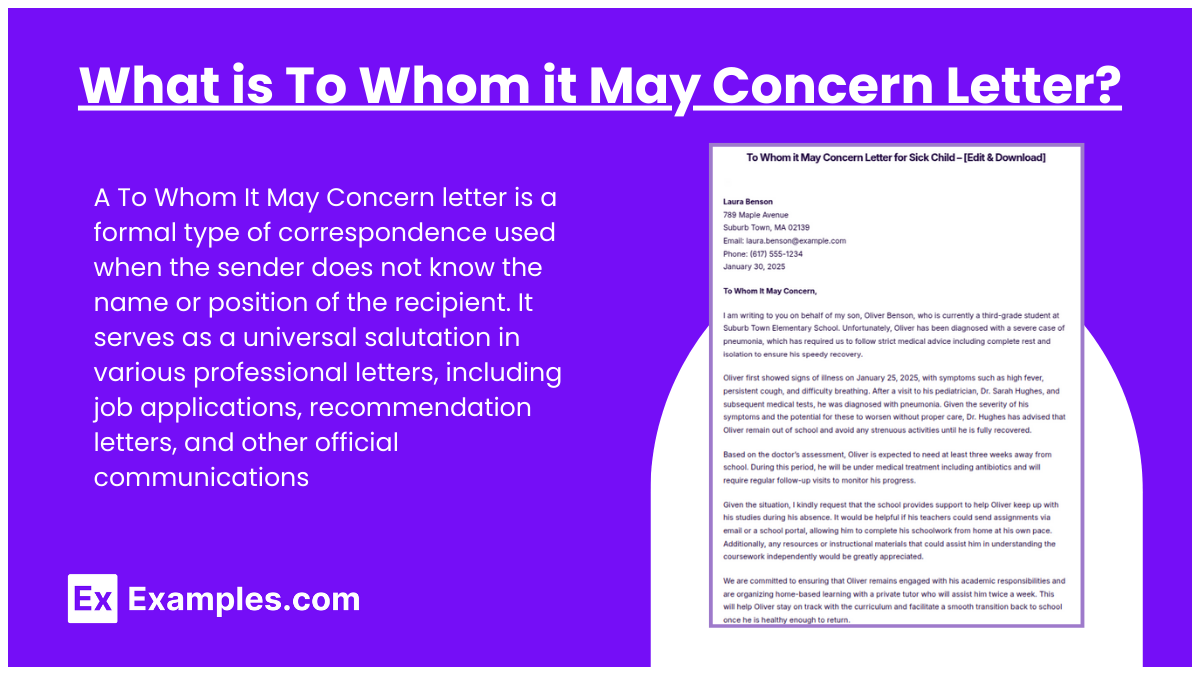
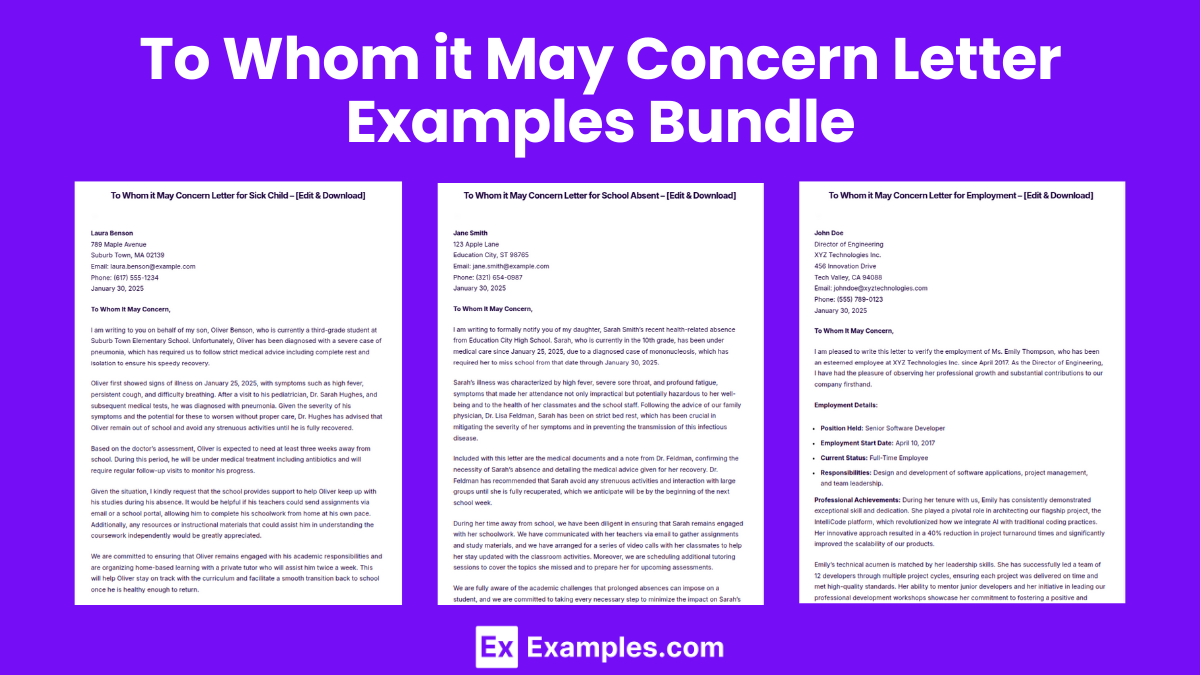
To Whom it May Concern Letter Examples Bundle
To Whom it May Concern Letter Format
Header
Include your contact information at the top of the letter, followed by the date, and then the recipient’s contact details if available.
Salutation
Begin the letter with the salutation “To Whom It May Concern,” followed by a comma.
Introduction
Start with a brief introduction stating the purpose of your letter.
Body
Write one to three paragraphs explaining the details of your request or the information you are conveying. Focus on a single main idea in each paragraph.
Conclusion
Conclude with a polite closing statement, reiterating your main point or request politely.
Closing
Use a formal closing, such as “Sincerely” or “Respectfully,” followed by your signature and printed name.
To Whom it May Concern Letter Example
John Doe
123 Main Street
Anytown, CA 12345
Email: john.doe@example.com
Phone: (123) 456-7890January 30, 2025
ABC Corporation
Human Resources Department
456 Industry Road
Businesstown, NY 67890To Whom It May Concern,
I am writing to express my strong interest in the Software Engineer position listed on your company website. With a robust background in computer science and extensive experience in software development, I am confident in my ability to contribute effectively to your team.
During my previous role at Tech Innovations, I successfully led a team that developed a pioneering mobile application, which resulted in a 50% increase in productivity for our clients. My strong technical skills, coupled with my ability to adapt to new technologies, make me a suitable candidate for this position.
I am very enthusiastic about the opportunity to work at ABC Corporation because of your company’s commitment to innovation and quality, which aligns perfectly with my professional qualifications and career goals.
Thank you for considering my application. I look forward to the possibility of discussing this exciting opportunity with you. Please feel free to contact me at your earliest convenience to schedule an interview.
Sincerely,
John Doe
To Whom it May Concern Letter Examples
To Whom it May Concern Letter for School Absent
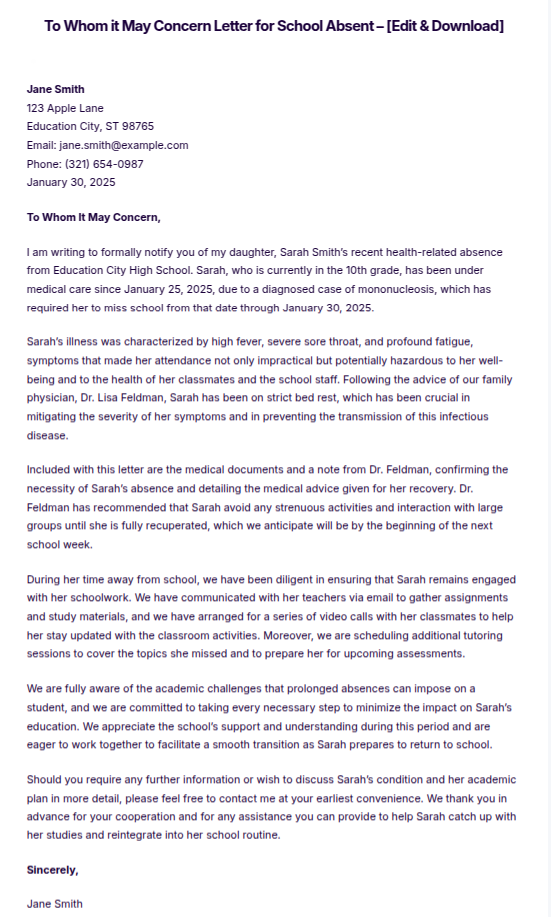
To Whom it May Concern Letter for Employment
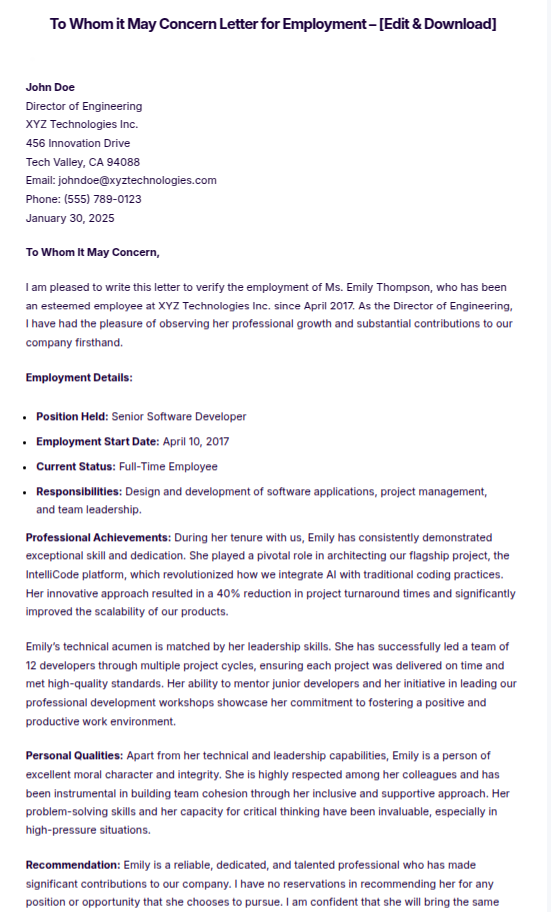
To Whom it May Concern Letter for Sick Child
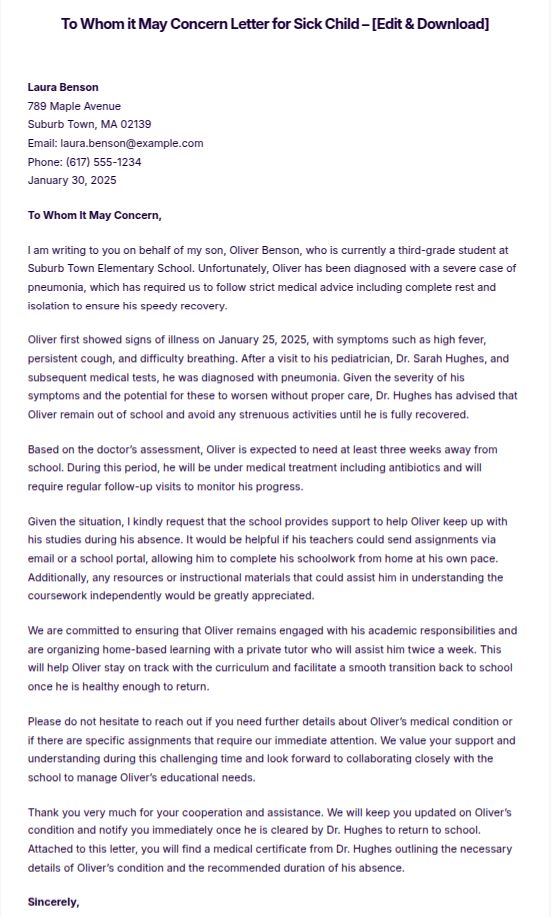
More Examples on To Whom it May Concern Letter
- To Whom it May Concern Letter for Court
- To Whom it May Concern Letter for Missing School
- To Whom it May Concern Letter for Immigration
- To Whom it May Concern Letter for Job Application
- To Whom it May Concern Letter for Authorization
- To Whom it May Concern Letter of Recommendation
- To Whom it May Concern Letter of Financial Support
- To Whom it May Concern Letter Doctor
To Whom it May Concern Letter

To Whom It May Concern Letter for Employee
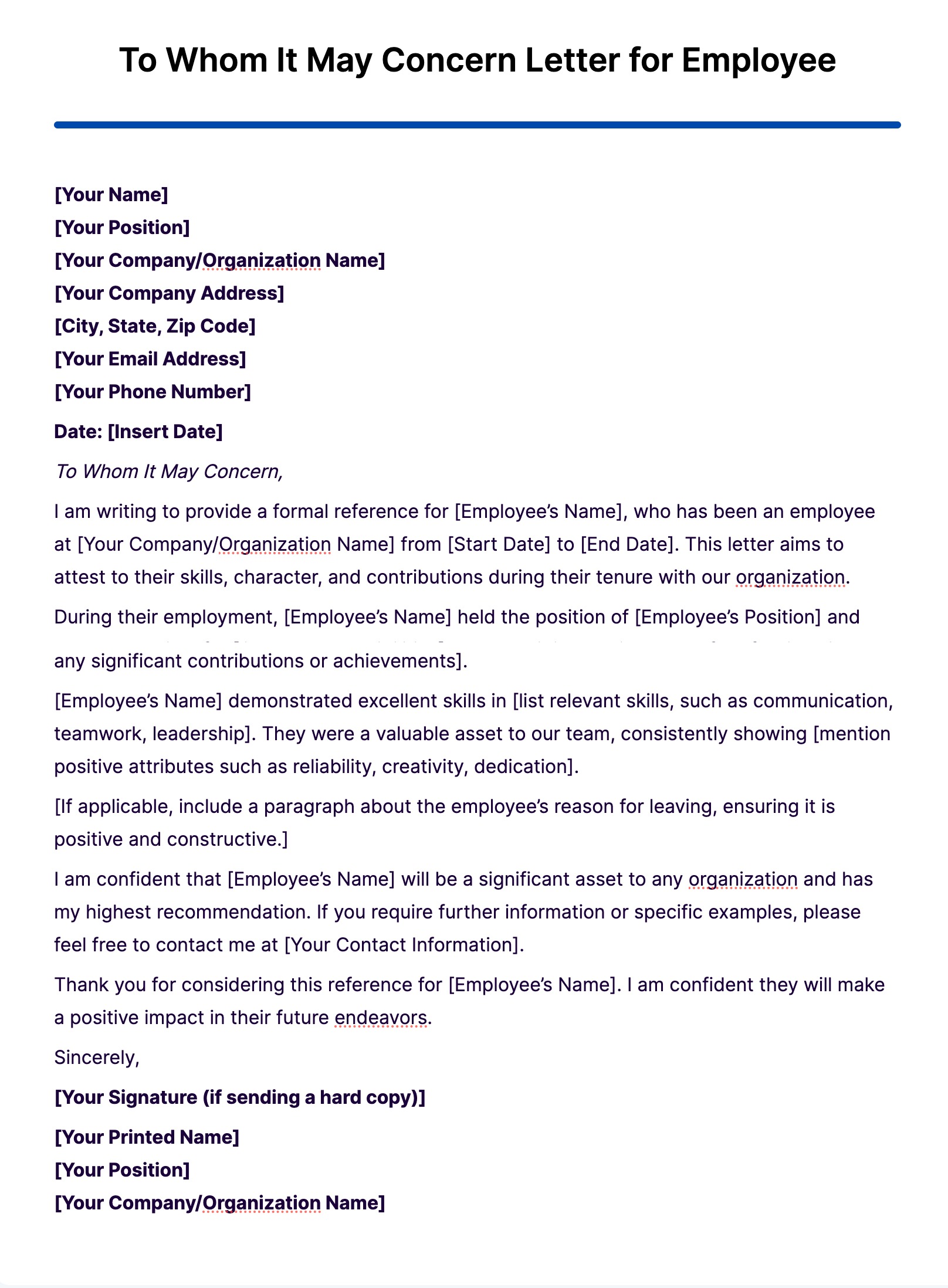
To Whom It May Concern Letter for School
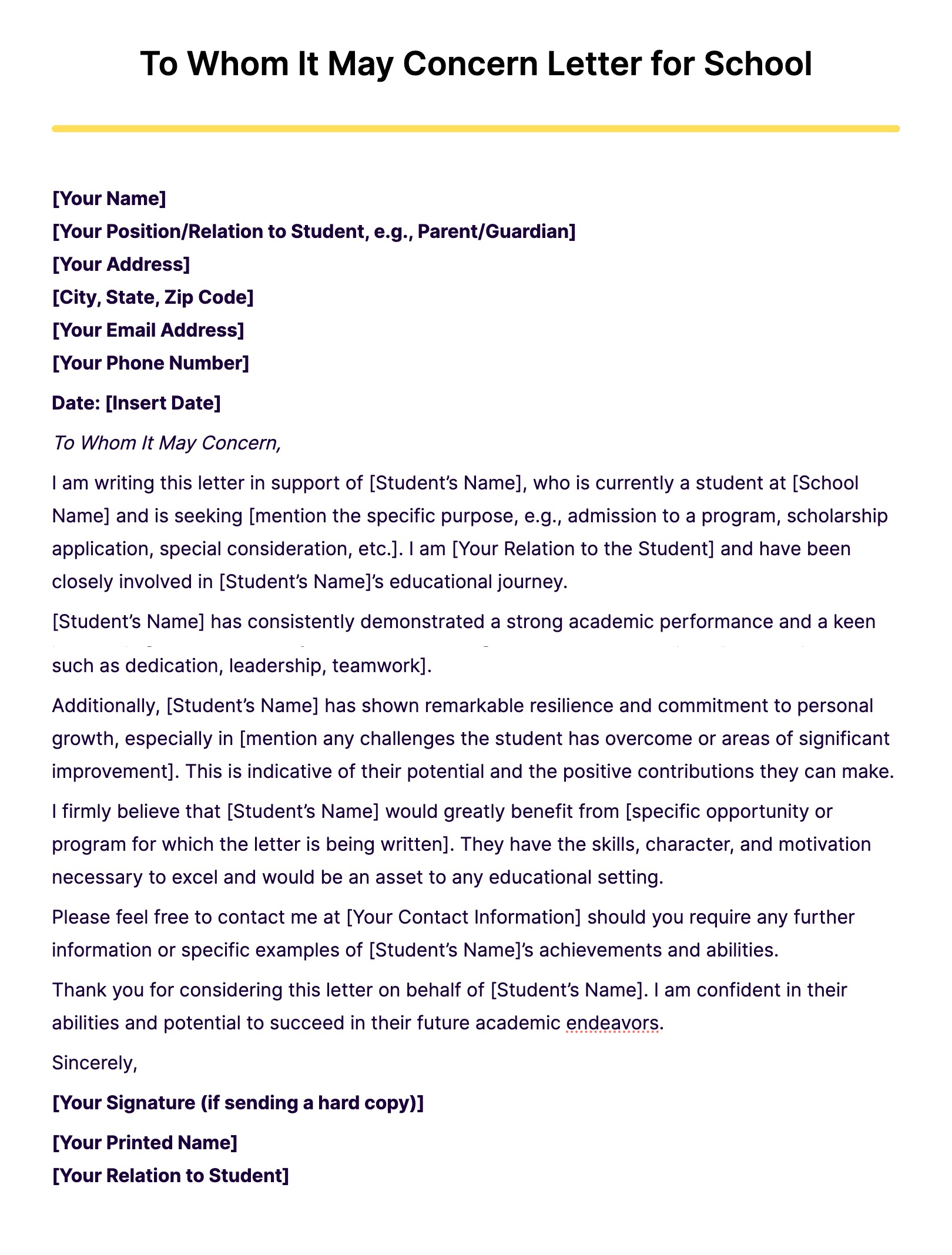
To Whom it May Concern Employee Letter

Types of To Whom it May Concern Letter
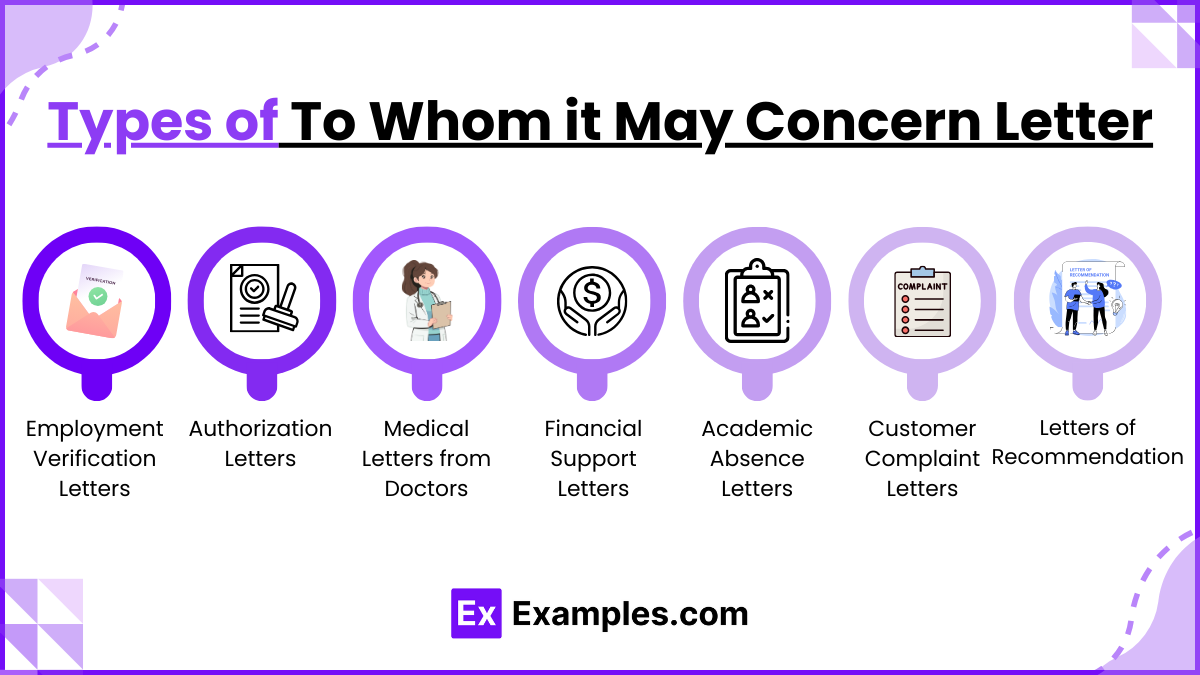
Employment Verification Letters
These letters confirm an individual’s employment status, job title, salary, and the period of employment. They are often required by landlords, financial institutions, or prospective employers.
Authorization Letters
This type grants a specified individual the authority to act on behalf of the letter writer in certain situations, such as financial transactions or personal affairs.
Medical Letters from Doctors
These are written by physicians to outline a patient’s medical condition and any needed accommodations. They might be used for insurance claims, job accommodations, or legal purposes.
Financial Support Letters
Often used in immigration cases, these letters declare that the writer will financially support the individual named in the letter, detailing the extent and duration of the support.
Academic Absence Letters
Parents or guardians might write these to explain a child’s school absence due to illness, family emergencies, or other reasons.
Customer Complaint Letters
Addressed to companies or institutions, these letters express dissatisfaction with a product or service when the appropriate contact is not known.
Letters of Recommendation
Used in academic and professional settings, these letters vouch for an individual’s skills, character, and achievements. They are typically addressed to admissions offices or hiring managers when the specific recipient is not known.
How to Write a To Whom It May Concern Letter

- Proper Formatting: Start with your contact information at the top, followed by the date, and then the recipient’s address if known. Use a formal business letter format.
- Salutation: Use the salutation “To Whom It May Concern,” followed by a comma or colon. Ensure this is capitalized as it is a formal greeting.
- Clear Introduction: Begin with a clear statement of the purpose of your letter. Introduce yourself if necessary and explain why you are writing.
- Detailed Body: In the body, provide all necessary details the reader needs to understand your purpose and message. Keep it concise but comprehensive, focusing on relevant information only.
- Polite Conclusion: Conclude with a summary of your request or the main point of the letter. Politely prompt any necessary action you wish the reader to take.
- Formal Close: End with a formal closing line such as “Sincerely” or “Respectfully,” followed by your signature (if sending a hard copy) and typed name.
- Proofread and Edit: Always proofread your letter for grammar and spelling errors to ensure professionalism. Consider having someone else review it to catch any mistakes you might have missed.
When to Use “To Whom It May Concern” in Letter
- Unknown Recipient – When you don’t know the specific person to address, such as in job applications or company inquiries.
- Multiple Recipients – When the letter is meant for a department or organization rather than an individual.
- General Recommendations – When writing reference or recommendation letters that could be used for multiple applications.
- Official Business Letters – For formal letters sent to banks, government agencies, or legal institutions.
- Authorization or Verification Letters – When granting authority or verifying information without a specific recipient in mind.
How to Use “To Whom It May Concern” Letter
- Capitalize Every Word – Always write “To Whom It May Concern” with each word starting with a capital letter.
- Use a Comma or Colon – Typically, a comma is used after the phrase, but a colon is acceptable in highly formal contexts.
- Follow with a Clear Introduction – Begin the letter with a brief statement explaining the purpose of writing.
- Maintain a Professional Tone – Ensure the letter remains formal, clear, and concise throughout.
- Consider Alternatives – If possible, research the recipient’s name to personalize the letter instead of using this generic greeting.
Tips for Writing To Whom It May Concern Letter
- Be Specific and Clear – Clearly state the purpose of the letter and provide necessary details concisely.
- Use Professional Language – Keep the tone formal, polite, and to the point.
- Keep It Well-Structured – Follow a standard format with an introduction, body, and conclusion.
- Provide Contact Information – Offer a way for the recipient to follow up if needed.
- Proofread Carefully – Check for spelling, grammar, and formatting errors to ensure professionalism.
FAQs
What are alternatives to “To Whom It May Concern”?
Alternatives include “Dear Hiring Manager,” “Dear Admissions Committee,” “Dear Customer Service Team,” or directly addressing the specific department or organization if a contact name is unavailable.
How do I ensure a “To Whom It May Concern” letter is professional?
Keep the letter concise, use formal language, ensure proper formatting, and proofread for errors. Clearly state your purpose and provide necessary details while maintaining a respectful and professional tone.
Is “To Whom It May Concern” outdated?
It is still acceptable but considered impersonal. Using a specific name or title is preferred for a more professional and engaging approach in modern business and formal communications
How should “To Whom It May Concern” be punctuated?
Capitalize each word and follow with a colon: “To Whom It May Concern:”. This maintains proper formatting and ensures a professional tone in formal letters and business correspondence.
Can I use “To Whom It May Concern” in an email?
Yes, but it’s best to avoid it if possible. Emails are more personal, so try to find the recipient’s name or use alternatives like “Dear [Department] Team” or “Dear Hiring Manager.


